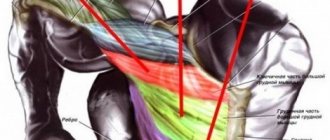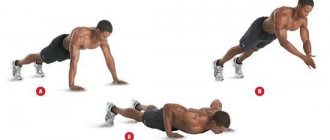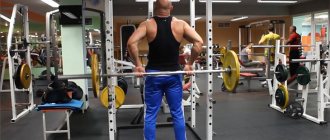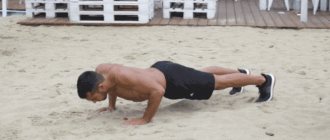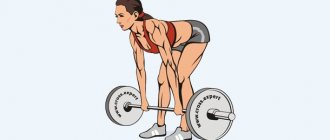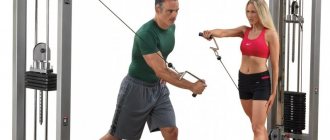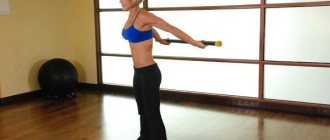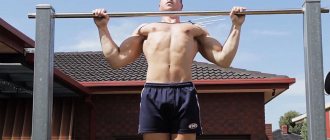Choosing dumbbells for pumping up the pectoral muscles
If you are a girl, you should be more careful when pumping up your breasts - first your breasts will rise, and it will look beautiful. This effect will be achieved due to the fact that the muscles will become toned. Then they will begin to grow. And it may not be so beautiful anymore. Therefore, act depending on your goals: to tighten or pump up. The weight of dumbbells in your case will also depend on the corresponding goal.
Dumbbell row for girls and assembled dumbbells for men.
For men everything is simpler. The more weight the dumbbell has, the better the muscles will grow. That's why:
- We choose a weight of 12 kg and above. Preferably 18–20 kg.
- Choose collapsible shells. The more plates you can hang on a short bar, the better.
- Pay attention to the possibility of further weight gain. For example, if the bar is long enough, you can first buy 12 kg dumbbells, and then buy additional weights as needed.
- It is better to take rubberized pancakes.
- Another great solution (but expensive and not entirely rational for home use) is to buy a row of dumbbells in 1 kg increments; this will be an ideal option for muscles (you don’t waste time assembling weights).
Remember to lubricate the dumbbells regularly to maintain the threads.
Correct technique
It would seem that it could be simpler - we put the backrest on an incline of 30 degrees, sit on a bench, dumbbells in our hands, lower ourselves, press our shoulder blades and pelvis, bring the dumbbells up, lower them, squeeze them out. But here too there are “platforms for discussion”:
- Some coaches consider the dumbbell bench press to be a technical error if the back is in a natural arch. They consider this deflection to be analogous to a lifter’s “bridge” and say that this does not allow them to pump up their chest;
- Others argue that when the shoulder blades are brought together and lowered to the floor, and the pelvis is rigidly fixed, it does not matter where the athlete's lower back is located. There is no particular meaning in her “forcible” pressing to the bench. But the heads of the shoulders, looking forward, are a violation of the anatomical plane of the joint, and the cause of injuries
Does the chest work if the lower back is separated from the bench? Yes, because otherwise it is simply not possible to start from the bottom position of the bench press. In order to achieve emphasis, you should simply lower the dumbbells completely.
Is it possible to get injured if your back is arched during the bench press? Yes, too, but only when the athlete lies unstably on the bench, his legs are relaxed, and his top is “assembled”, but not correctly. This refers to the adduction of the trapezius muscle to the ears.
In fact, the correct technique is possible by:
- Shoulders away from the ears;
- Assembled blades;
- Firmly rest your feet on the floor, without them slipping;
- Work along the correct trajectory, without pushing the dumbbells towards the eyes
The back should be stable, not neutral. “Jumping” on the bench, attempts to push the weight up, and changing the position of the lower back are not allowed. If it is slightly bent and the athlete is comfortable in this position, it’s okay.
Technically, the bench press is performed like this:
- The athlete sits on a bench, brings his shoulder blades together and removes his shoulders from his ears;
- Then he lies down in his original position;
- The assistant helps to bring the dumbbells to the level of a line passing through the plane of the middle of the chest;
- Dumbbell bars are perpendicular to the spine, the grip is straight and closed;
- Wrist creases are excluded;
- As you inhale, lower the dumbbells to the lowest point of amplitude, if possible, closer to the point at which the bar of the bar could rest on your chest during a bench press;
- As you exhale, you need to consciously tighten your chest and push the dumbbells up;
- Another controversial point is the position of the elbows. Should I extend it completely or leave it slightly bent? If control over the implements is not lost with “soft elbows,” you don’t have to fully extend them. But those athletes who cannot hold dumbbells in a way that keeps their bars stable should use lighter weights and stick their elbows in.
Important:
- When performing bench presses to work the pecs, pay attention to the angle of the bench. If the back is tilted at an acute angle, the load shifts to the front deltoids. It is ideal to place the bench at 30-45 degrees and no more;
- There is no need to choose dumbbells that are too heavy. Heavy weight allows you to achieve significant hypertrophy, but if an athlete cannot keep the bars in one plane, “pulls” the dumbbells up on one side, and actively hyperextends his elbows, he provokes injury. A little muscle shaking and instability is allowed during the last reps.
- Overload of the cervical spine should be avoided. Athletes who rotate their heads during exercise, try to put weight on the neck, and actively overload the cervical spine can cause a pinched nerve. If you have an irresistible desire to stand in a kind of bridge with support on your neck, do not flatter yourself - the dumbbells are too heavy, you should choose an adequate weight. If such a mistake is repeated regardless of the weight of the dumbbells, you should place a pancake or other support under the bench, since it is simply too low and the athlete “warps” because of this;
- When lifting dumbbells on your own without the help of a spotter, they are not lifted onto the biceps or brought up from the floor. They are placed on the hips and raised by pushing the legs;
- Before pressing dumbbells, you need to straighten your back on the bench and stabilize your body position, so that when lowering the dumbbells, your pecs are stretched
Selecting an Incline Bench
There are many types of reclining benches at different price points. Note the ease of changing the angle. We do not recommend taking benches where you need to unscrew or tighten something. It takes a long time and is not always convenient. Moreover, one day such a mechanism will break.
It is best to buy a bench where each corner is marked with a fixing protrusion on the load-bearing parts. Thus, you can quickly change the angle by simply moving the backrest from one position to another.
We will need 4 bench positions. Please note that the bench can be set at angles of 15, 30, 45 degrees to train different parts of the pectoral muscles. The fourth position is horizontal.
We also pay attention to the material of the bench covering. By the way, during training we recommend placing a towel under your head so as not to spoil the covering.
Let's start pumping up the chest
Since you are working out at home, you need to pay special attention to warming up. You can use a jump rope, or purchase an elliptical, exercise bike, or treadmill. If it's expensive, running in place for 3-5 minutes will do. This is necessary to warm up all the muscles.
Then stretch the joints of your neck, shoulders and arms. After this, you can begin the first warm-up approach.
Remember golden correctly! The first approach is a warm-up. It is performed with empty dumbbell bars. Starting with a working weight is a lot of stress even for hot muscles.
Lying dumbbell flyes
Place the bench in a horizontal position.
- Take the dumbbells apart. Sit on the edge of a bench with your hands and weights on your knees.
- Lie down so that your buttocks, back and head are on the bench. Nothing should be hanging. The legs are slightly apart and the knees are bent 90 degrees or less. You must lie steady. Keep the weight close to your chest.
- Extend your arms so that they are perpendicular to the floor. The vultures are located parallel to each other. The arms are slightly bent at the elbows.
- We begin to spread our arms to the sides. We make sure that they move strictly sideways and downwards. Moving your arms forward and back is not allowed. When moving, your elbows go to the floor. You can't let your elbows turn upward. Make sure your arms are slightly bent.
- Extend your arms as far as the stretch allows. Feel your pectoral muscles stretch.
- Do 10 warm-up reps with empty weight.
- Sit down, set the working weight and do 3 sets of 10 times slowly and correctly. Watch your movements: they should be smooth, without jerking.
This is a classic pose to tone your midsection.
Dumbbell flyes at different angles
In one day it is allowed to do 2 wiring with different angles:
- Classic wiring + at an angle of 30 degrees.
- Classic dumbbell flyes lying down + at an angle of 45 degrees.
The higher the backrest is set, the greater the load on the upper chest.
You need to combine these exercises, depending on how many times a week you plan to train. If twice a week, then the first workout includes the classics and a 30-degree fly, and the second includes a 45-degree fly.
In this case, your lower chest is not involved. Unfortunately, it is very difficult to pump it up at home. But we will try to help you in this matter.
The exercise technique for 30 and 45 angles will be similar, so we will describe it step by step for 30 degrees:
- We set the backrest angle of the bench press to 30 degrees. We sit down and take empty bars for a warm-up approach.
- We lean on the back. We remember the natural curves of the spine in the lower back and chest during the exercise, shoulders straightened.
- Raise your slightly bent arms up perpendicular to the floor. We begin to move them apart strictly in one plane. Forward and backward movements are not allowed.
- Elbows point down. Technically, this option differs from the classic one only in the angle of inclination of the bench. The rest of the points are the same.
- We do 10 warm-up repetitions, set the desired weight and work according to the chosen scheme.
The best chest exercises
Proper chest training with dumbbells involves engaging not only the chest muscles, but also the muscles of the shoulders and arms. Note that the latissimus dorsi muscle, the deltoid muscle of the shoulders, as well as the pectoralis major and minor muscles are a single fascia woven together by connective tissues. The mechanics of movement when using dumbbells involves the unified work of the entire upper body.
When talking about the best exercises with dumbbells for pumping up the pectoral muscles, it is important to divide them into basic and isolating exercises. The former are recommended for beginners, while the latter are suitable for professional athletes who specifically train specific areas of the chest
It is also important for beginners to carefully study the exercise technique with a trainer to avoid injury to the shoulder joint.
Basic chest exercises with dumbbells
| Dumbbell bench press A basic exercise for the pectoral muscles. It is analogous to the bench press. | |
| Dumbbell push-ups A more complicated variation of regular push-ups, performed with dumbbells. Develops chest, shoulders and abs. | |
| Dumbbell Pullover The most important exercise for expanding the chest, as well as for working the serratus chest muscles and latissimus dorsi muscles. |
Isolation chest exercises with dumbbells
Using dumbbells implies the ability to easily change the movement - the palms with dumbbells can be either parallel to each other or on the same line. In addition, the angle of the bench can also change. With the head up, the exercise works the upper chest and shoulder girdle, while with the head down, the lower chest is included in the work.
| Lying dumbbell flyes An exercise to improve the shape of the pectoral muscles and work their midline. | |
| Hammer chest press Palms parallel, arms moving strictly up and down. Exercise to work the outer part of the pectoral muscles. | |
| Dumbbell head down press An exercise for pumping the lower part of the pectoral muscles. When performing, the press should be in conscious tension. | |
| Alternating dumbbell press This exercise relates to functional training and develops coordination of movements. When pressing, the shoulder blades are slightly brought together. | |
| Dumbbell Incline Press An exercise to work the upper chest and anterior deltoid muscles. When doing this, do not strain your neck. |
Features of warm-up and weight selection
The weight of the bar is usually from 1 to 2 kg, so for men, you should also hang the lightest weights as a warm-up. Warm-up weight should be 3-4 kg.
If your working weight is more than 15 kg per dumbbell, you should not lift it immediately after the first warm-up. Do another set (let it be 5 reps, not 10) with a weight of 8–10 kg. This “ladder” is necessary to prepare your muscles for working weights.
Each person's musculoskeletal system is unique. It is acceptable for some to lift working weights right away, while others will get injured afterwards. We recommend that absolutely everyone warm up before starting an exercise and before lifting weights.
Features of pumping the pectoral muscles
To pump up your pectoral muscles means increasing their size, not just strength. To do this you need to train in a certain way. Remember that at home you will not be able to achieve special results without a barbell and racks for it. You can get by with just dumbbells up to a certain point.
Your muscles will then need more work than dumbbells can provide. To do this you will need to perform a bench press. If there is no barbell, we will do dumbbell presses (which, in fact, is what this article is about).
When bench pressing dumbbells, you can take much more weight than when doing flyes. This is very good for muscles!
In order to pump up the pectoral muscle, we will exercise 2 times a week. You need to do 1-2 warm-up sets of 10 reps and 2-4 working sets of 8-10 reps.
If you decide to work “to failure” (this is the most effective method, but it doesn’t always work with dumbbells - the wrong weights), then do 8 repetitions. The last 2 repetitions should be given with great difficulty (by the way, this is a reason to call a partner for insurance).
Top 5 exercises with dumbbells for the back
In order to pump your back with dumbbells at home, you don’t need many exercises. These are mainly bent over rows in various variations, as well as a few specialized movements.
One-arm dumbbell row
One of the main movements. This is also a great dumbbell back exercise for women. Its main advantage is that you can adjust the weight in minimal increments. The movement mainly loads the latissimus dorsi muscles, although the rear deltoids and partly the trapezius are actively involved in the work.
Technique:
- Place your hand on a chair or bench (ideally, if you can place your knee on the same surface). Secure your body and lower the dumbbell at arm's length.
- Start pulling the weight towards your lower abdomen (closer to your hip).
- Pause briefly at the top and return the dumbbell to the starting position.
It is important that the body is in a horizontal position and securely fixed. Therefore, it is recommended to do this exercise on the back with dumbbells on a bench, where you can place emphasis on the arm and knee at the same time
The movement can also be performed while standing. In this case, it is better to do deadlifts with both hands at the same time.
Deadlift with dumbbells
This traction option is considered safer and more gentle. Moreover, due to the lack of ability to lift heavy weights, deadlifts are performed in a multi-repetition style. This is a basic dumbbell back exercise for men.
Technique:
- Place the dumbbells on the floor. Sit down with your back straight and grab the handles. This is the starting position.
- Begin to stand up slowly, straightening your body (while keeping your back straight).
- At the top point, exhale, pause briefly, and then return to the starting position.
It is important not to confuse this back exercise with dumbbells at home with the Romanian deadlift, in which the knees are not bent. When deadlifting, you should squat deeply, bending your knees
This is a more effective option when it comes to back training.
Dumbbell row to the chin
This is one of the best dumbbell back exercises if done correctly. Loads the upper part of the group (traps, rear deltoids). Very effective for correcting posture and creating powerful “tubercles” of the trapezius.
Technique:
- Stand straight, hold dumbbells with straight arms at the level of your quadriceps.
- Begin to slowly raise your arms, stretching (or rolling) the dumbbells along your body.
- Bring the weights as high as possible to the chin (a full lift is not necessary, it depends on the mobility of the joints, so it is enough to bring the weight to the level of the collarbone). Pause and slowly lower the projectiles to the starting position.
Important to remember:
- if you spread the dumbbells wider (conventionally wide grip), the load will predominantly fall on the deltoids (middle beam);
- To work the upper back, the grip should be narrower.
Bent-over dumbbell fly
These exercises with dumbbells to strengthen the back muscles are often included in the training program, despite the fact that its main goal is to pump up the rear deltas. It works together with other back muscles, so extensions can be included in both shoulder and back day.
Technique:
- Take dumbbells in your hands (light weight) and lean forward. Ideally, a right angle is formed between the legs and the body with a straight back. Dumbbells are held in free hands with slightly bent elbows.
- Begin to slowly spread the projectiles to the sides until your hand reaches parallel with the floor.
- Slowly return the weight to the starting position.
This back exercise with dumbbells for girls is especially useful because it allows you to turn your shoulders back, thereby pushing your chest forward.
Good morning exercise
A complex but very effective movement that should definitely be included in a set of exercises for the back muscles with dumbbells. Its main task is to develop the muscles of the lower back.
Technique:
- Take one dumbbell with a heavy or medium weight (you can do two, if you can fix them by pressing them to your shoulders or chest).
- Stand straight, with your feet slightly narrower than shoulder level. This is the starting position.
- Slowly lean forward, keeping your back straight.
- Pause for 1-2 seconds and level out at the same pace.
A straight back will play a key role when performing the exercise. When it circles, the movement will be more traumatic and ineffective. At first, athletes may have problems with stretching, so it is not necessary to bend over until the body is parallel to the floor.
Dumbbell Bench Press
The dumbbell press, like the fly, can be done in several positions even at home. The fundamental advantage of the bench press is that you can pump up the lower chest. Let's start with this version of the exercise.
Dumbbell upside down press
The bench press will not allow you to lie upside down, so you have two options:
- A wall bar and an inclined abdominal bench that is attached to it.
- Incline bench for the press.
Not every home has a wall bars, and it costs a lot. And an incline bench for the abdominal muscles will not be superfluous.
The exercise technique for the first and second options will be the same:
- We set the angle of the bench so that your head is 30–45 degrees lower than your feet. The lower your head is, the more you can pump up your lower chest.
- We lie down head down. For this exercise, you will need a partner to hand you dumbbells.
- Remember to start with a warm-up. Now we take 3–5 kg.
- We position our hands with dumbbells so that the angle between them and the floor is 90 degrees (that is, the hands are perpendicular to the floor).
- Imagine that you have a barbell in your hands and grip it a little wider than shoulder-width apart so that you can lower it as far as possible. That is, your hands with dumbbells are turned out as if you were holding a barbell in your hands.
- We begin to lower the dumbbells. The elbows go straight down along a path perpendicular to the floor.
- We lower our arms as far down as possible, feeling the stretch in the pectoral muscles.
- As you exhale, return your arms to their original position. We repeat 9 more times.
- Now let's take the working weights. It’s good if you can assemble a dumbbell up to 40 kg. Then you can definitely pump up your chest muscles. And behind them are the triceps of the arms.
- The number of repetitions for this exercise is 8-10. This is more than enough to pump up muscles.
Dumbbell Bench Press
This is where our favorite bench press comes to the rescue:
- Take an empty bar (or a light weight of 5–10 kg) and sit on the edge of the bench.
- We lie down on a bench and put our hands with dumbbells perpendicular to the floor. We turn the dumbbells so that their bars are on the same straight line.
- As you inhale, lower the dumbbells to their maximum possible position. Elbows look strictly at the floor.
- As you exhale, we return to the original state. We repeat the exercise 9 times.
- We sit down, set the desired weight and work for results.
The hands are positioned at the same width as in the “upside down” version. Pressing at an angle of 30 and 45 degrees is performed in the same way. Simply changing the angle of the bench press.
Exercises with a curved bar at home
To pump up your body using a curved bar, the following exercises are perfect for you:
- lifting the barbell with a narrow grip - this exercise must be performed standing. Thanks to a narrow grip, you can better pump up your biceps muscles. The curved model of the barbell can significantly reduce the load on your back and wrists. Perform this exercise in 4 – 5 sets of 15 repetitions. You can increase the weight yourself as soon as you feel that the approaches are easy for you;
- French bench press - to complete this task at home, you need to have a bench, or place several simple chairs nearby. The approach is performed while lying on a bench, the curved bar is taken with a pronated grip, and it must be held by the inner part. Starting position of your arms: extend straight so that the bar is perpendicular to the floor. Then smoothly and slowly, while inhaling, lower the barbell down, while bending your arms at the elbow joint until it touches the top of your head. Then return your hands back to the starting position. Weight can be gradually added for each set;
Important! Experienced trainers can tell you which bar to choose for practicing at home. If you doubt the correctness of your choice, contact a specialist with this question before purchasing it yourself
swing the barbell forward - this task must be performed while standing. Bend your elbows slightly. In order to place more load on the deltoid muscle, you can grab the barbell with an underhand grip. The principle of the exercise is that you need to slowly raise it to shoulder level, or a little higher, fix it at the top point of the arm for a few seconds, and then return it to the starting position again. The weight for the barbell should be such that you can do at least 10 repetitions correctly. Try to increase your loads each time.
With this simple sports equipment, you can easily achieve stunning results from home workouts after just a short period of time. The best barbell exercises at home will give you the definition you want.
The main principles of your home workouts should be: avoiding laziness, perseverance, setting goals, believing in your own strength, including cardio exercise in your program and proper nutrition. Only in this case, even without visiting a sports club and following the instructions at home, will you be able to bring your body back to normal and achieve the desired shape.
Lack of free time in the rhythm of your life should not be an excuse for exercising.
How to properly belay when pressing and raising dumbbells
When you lift light weights, you don't need a safety net. But heavy ones are a separate matter. There is no need for insurance for wiring. But for the bench press it’s very necessary.
Attention to belayers:
- You stand next to the head of the person pressing so that you can easily reach his elbows.
- Watch his movements carefully. If a person starts to slow down at the bottom point and cannot get out of there, help him by pushing his elbows. The strength of your efforts should be such that the practitioner can complete the exercise with maximum tension.
- If the dumbbells are heavy, help your partner take the second dumbbell (he takes the first one himself and takes the starting position with it).
- You don't have to do all the work for your partner. If necessary, support his elbows with a few fingers, this is ideal for his muscles.
Workout 1: Chest and Back (Week 1)
1A Bench press on the floor
Sets: 4, reps: 10, rest: 0 sec, tempo: 2010
Technique: Lie on the floor, holding dumbbells with straight arms above your chest. Lower the weight to your chest, then lift it up to the starting position.
Note: Lying on the floor provides you with a stable position that allows you to handle heavier weights. The range of motion here is shorter than the classic bench press, so focus on properly contracting your chest muscles.
1B Bent-over row with hammer grip
Sets: 4, reps: 10, rest: 0 sec, tempo: 2010
Technique: Hold a dumbbell in each hand with your palms facing each other. Bend forward and then pull the dumbbells toward your chest. Using a controlled movement, lower the weight back to the starting position.
Note: This exercise targets the large muscles of the upper back. Its lower part is under tension to support the torso in an inclined position. The hammer grip allows you to work your forearms.
2A Push-ups with dumbbells
Sets: 4, reps: 10, rest: 0 sec, tempo: 2010
Technique: take dumbbells, take a lying position with your hands shoulder-width apart. Brace your core and straighten your body into a straight line from head to toes. Bend your elbows, lower your body, and then with an energetic movement, straighten your arms and return to the starting position.
Note: Push-ups are effective for building chest muscles, especially when you use dumbbells to add instability to the movement, which forces your core muscles to engage.
2B Bent-over dumbbell raises
Sets: 4, reps: 10, rest: 60 sec, tempo: 2010
Technique: Hold a light dumbbell in each hand and lean forward without rounding your back. Maintaining a slight bend in your elbows, lift the dumbbells to shoulder height, then lower them back to the starting position.
Note: This exercise literally works wonders for your upper back and rear deltoids. Start with light weights and master the technique thoroughly to maximize muscle strength and reduce the risk of injury.
3A Wide Hand Push-Ups
Sets: 4, reps: 10, rest: 0 sec, tempo: 2010
Technique: Take dumbbells, lie down, spread your arms wide and bring your legs together. Brace your core and straighten your body into a straight line from head to toes. Bend your elbows to lower your body, and then vigorously straighten your arms and return to the starting position.
Note: Wide stance reduces the involvement of the triceps and shoulders, so that the main load falls on the chest muscles.
3B Lying dumbbell row
Sets: 4, reps: 10, rest: 60 sec, tempo: 2010
Technique: take dumbbells, lie down with your hands shoulder-width apart. Brace your core and straighten your body into a straight line from head to toes. Pull one dumbbell toward your chest, lower it back down, and then repeat with the other arm.
Note: One movement of this exercise works one side of your upper back (so you can fully target every muscle) and also forces you to engage your core and shoulder joints to keep your body in a stable position.
Week 2
| Exercise | Approaches | Repetitions | Rest, sec | Pace |
| 1A Bench press on the floor | 4 | 12 | 2010 | |
| 1B Bent-over row with hammer grip | 4 | 12 | 60 | 2010 |
| 2A Push-ups with dumbbells | 4 | 12 | 2010 | |
| 2B Bent-over dumbbell raises | 4 | 12 | 60 | 2010 |
| 3A Push-ups with wide arms | 4 | 12 | 2010 | |
| 3B Lying dumbbell row | 4 | 12 per side | 60 | 2010 |
Week 3
| Exercise | Approaches | Repetitions | Rest, sec | Pace |
| 1A Bench press on the floor | 4 | 10 | 2010 | |
| 1B Bent-over row with hammer grip | 4 | 10 | 60 | 2011 |
| 2A Push-ups with dumbbells | 4 | 10 | 2010 | |
| 2B Bent-over dumbbell raises | 4 | 10 | 60 | 2011 |
| 3A Push-ups with wide arms | 4 | 10 | 2011 | |
| 3B Lying dumbbell row | 4 | 10 per side | 60 | 2010 |
Program options for training the pectoral muscles with dumbbells
To pump up your pectoral muscles as effectively as possible, you need to alternate all of the listed exercises. Let's say you don't have a barbell and you only train with dumbbells. Let's proceed from this.
Day 1:
- Dumbbell bench press: 4 x 8–10 reps.
- Lying dumbbell flyes: 3 x 8–10 reps.
- Dumbbell flyes at an angle of 30 degrees: 2 sets of 8-10 reps.
Day 2:
- Dumbbell press upside down (or parallel to the floor again if you don't have an incline ab bench): 4 x 8-10 reps.
- Dumbbell press at a 45 degree angle: 2 x 8-10 reps.
- Dumbbell flyes at a 45 degree angle: 3 x 8-10 reps.
- Lying dumbbell flyes: 2 sets of 12 reps with light weight.
And don’t forget to eat right, then the exercises will give results faster! Muscles need a lot of protein, remember this.
